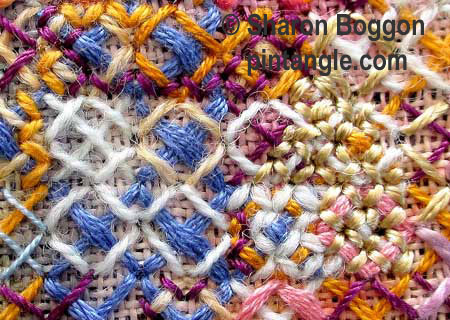 This tutorial offers a step-by-step illustration of Rice Stitch and explores some of its variations including a stitch called Boss Stitch.
This tutorial offers a step-by-step illustration of Rice Stitch and explores some of its variations including a stitch called Boss Stitch.
 Rice stitch is also known as Crossed Corners and William and Mary stitch.
Rice stitch is also known as Crossed Corners and William and Mary stitch.
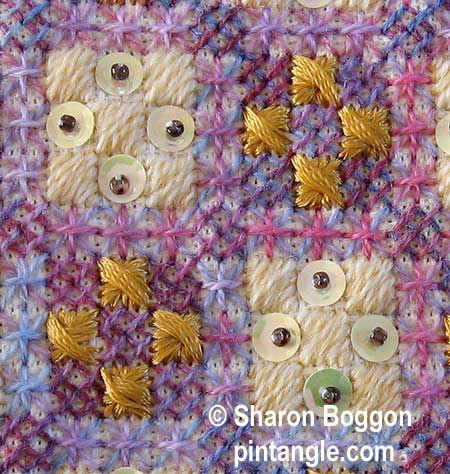
At first glance, it looks a little boring, but it is tremendously versatile. Some know it as a canvas background stitch because you can work it easily and it covers the ground quickly. To be honest, I am a little addicted to it as I love mixing my threads in the different layers or parts of the stitch.
Don’t let the fact that it is a canvas stitch put you off. In fact, you can work many of the canvas stitches on Aida (like the samples illustrated) or any even-weave fabric to great effect. If you want to work it on other fabric or over an area of crazy patchwork use waste canvas.
How to work Rice Stitch
This is how you work Rice stitch. As you can see, it is very simple consisting of a cross-stitch foundation with a second layer of diagonal stitches added to each arm of the cross.
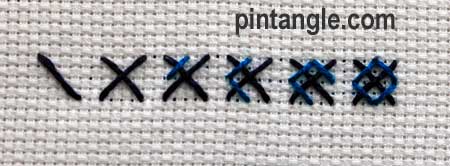 How to work Variety 1 and 2 of Rice Stitch
How to work Variety 1 and 2 of Rice Stitch
I want to share two varieties (there are a lot more) As you can see, they all have the same structure
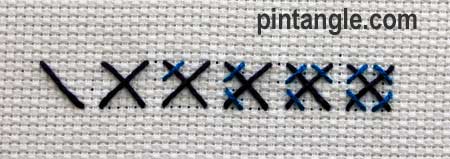 This variety is a cross worked over more threads so that the diagonal stitches sit apart slightly.
This variety is a cross worked over more threads so that the diagonal stitches sit apart slightly.
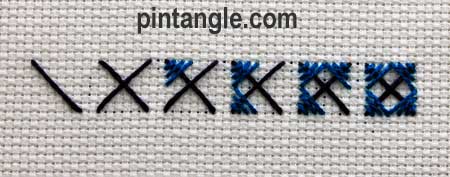 The next variety has 3 diagonal stitches worked across each bar.
The next variety has 3 diagonal stitches worked across each bar.
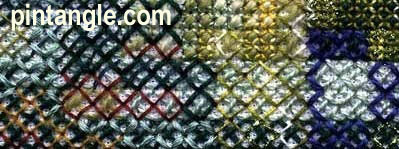 You can really have fun with this stitch, particularly if you change threads. You can use one thread or colour for the large cross and another thread or colour for the corner tie-downs. Swap between thick and thin, metallic and dull or explore colour combinations. Change the size of your stitches or add beads or French knots to really give the stitch a texture contrast. It is one of those simple stitches that can produce interesting results.
You can really have fun with this stitch, particularly if you change threads. You can use one thread or colour for the large cross and another thread or colour for the corner tie-downs. Swap between thick and thin, metallic and dull or explore colour combinations. Change the size of your stitches or add beads or French knots to really give the stitch a texture contrast. It is one of those simple stitches that can produce interesting results.
I hope you enjoy experimenting with Rice Stitch.
Floral themed Stitchers templates for hand embroiderers
I designed this set of stitchers templates around a floral theme. With this set, you can combine petal and leaf shapes with the curved edges of the templates to create all sorts of floral and organic motifs and create hundreds of different patterns to embroider. It is the ultimate mix-and-match fun for stitchers.
The set comes with an e-book with instructions and is filled with patterns and designs that you can create and use as jumping-off spots for your own designs.
They are available now in our shop here
Enjoy your stitching!

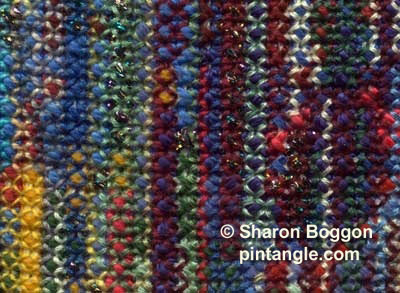

Thankyou so much for hosting TAST 2020. I feel sad to say good bye to TAST 2020. I thoroughly enjoyed every stitch of TAST 2020 and Beyond TAST 2020.
My sample of Rice Stitch is here
http://hobbysewing.blogspot.com/2020/12/tast-48-beyond-tast-48.html
Congratulation Rad on your finish
Love this Rice Stitch Sharon. Thank you for such clear stitching details. Happy Christmas and I hope it doesn’t get too hot over there.
Best wishes Andy LW, Bath
Hi Andy great to hear from you – Happy Christmas we are facing 40 today (104 in the old measure) but at least the smoke haze has cleared a bit
Oh I love this rice stitch. I started a book marker with black perle cotton and did the little corner crosses with red. Looks great!!
Thanks Judy I am so pleased you like it
2018 week 15 TAST challenge: https://www.thecrafties.com/2018/05/tast-rice-stitch/
I like both diagram and picture. I get a better sense of HOW to do the stitch with a diagram and a better sense of what it LOOKS like with photo. So use both!
My Rice stitches are here:
http://queeniepatch.blogspot.jp/2014/04/tast-108-rice-stitch-and-variations.html
I prefer the stitch photographs over schematics most of the time because it gives me a better idea how my work should actually look. However, I’ll go with the majority since I can work with both.
Personally, I’m not a big fan of beaded embroidery and ribbon work, but I will find uses for canvas stitches, pulled stitches and drawn thread work almost everywhere. So I’d say yes to as much variety as possible, everybody will find something they enjoy and the others maybe are tempted to do something out of their comfort zone.
However, availiability of the right materials is a concern. Maybe it would help if you could do “mini-series” of such stitches with a few surface embroidery stitches thrown in and maybe announce them like a week before they start, so we can decide if we want to aquire the necessary materials.
I know, I haven’t posted here for more than a year, but I’m actually working on a rice stitch sample.
Hi Tenar thanks for your considered reply I will be going with photos instead of diagrams as most people prefered that and I agree some discussion about the need for different materials has to be covered
Hi Sharon,
Hope you enjoyed your time out.
Thanks for the seam treasures you shared.
my square boss stitch sampler is started here-
http://jizee6687.wordpress.com/category/tast-2014/15-109-square-boss-stitch/
Thank you,
Chitra
http://anaslua2.blogspot.de/2014/04/take-stitch-tuesday-108-rice-stitch-and.html
My stitch sample is 4 rows longer now.
hi sharon ,my sample for tast 104,108,109 are here http://needlwork.blogspot.com/2014/04/tast-104-108-109-cushion-cover-3.html
I just finished an Easter egg for a SAL with lots of old TAST stitches:
http://fat-quarter.blogspot.nl/2014/04/easter-egg-sal-4.html
Here is a row of varieties of Rice Stitch and a few Square Box Stitches in different sizes.
http://210920746822434353.weebly.com/1/post/2014/04/take-a-stitch-tuesday-108-and-109.html
Hi Sharon, I really enjoy learning new stitches with your photos and step by step instructions. I would like you to teach us Pulled and Drawn Thread embroidery. If your time is limited perhaps we could have a “Take a Pulled and Drawn Thread Monthly” and create a sampler or some other type of item combining the monthly stitches we learn from you. Best wishes, Dianne
Sharon, I am just happy that you are so willing to share what you know that I will gratefully receive whatever you give. I don’t actually do canvas work but as you say many of the stitches can be adapted to other forms of embroidery, and the same applies to pulled and drawn thread stitches. If there is one that can’t be adapted, so be it, it’s interesting to learn about these stitches and what they were used for in any case.
Hi Sharon, I’ve read all of the comments and agree your method of photos and step by step beats diagrams hands down..
I’m happy to learn any new stitch but lately have wished to learn Pulled or drawn needlework. Time would be more a factor for this style I think but if it goes ahead I’d be in it.
I like the two week apart TAST posting.
I’m hoping to join the Hussif challenge, a long time wish of mine and bound to be completed in a group.
I think stitches for a variety of uses is very educational. Will you have a code or something, so we know which are for beading, which are only for x-stitch, and which can be used multiple ways, including freeform? I also find the traditional instructions that show the needle angle, etc. to be very helpful. I am not advanced and fear I would be lost without those photos. Thank you so much for all you do!
Hi jane I already tag the stitches under what they can be used – I started it about 6 months agao and am getting better at remembering to do it – eventually people will be able to search via the tags and get all the types of stitches. I will continue using photos as to be honest they are easier to do!
I personally like surface stitches, and don’t really do canvas stitches.. I especially love the beaded stitches you’ve brought forth.
Will you please explain what you mean when you say “use waste canvas”? Do you use it to mark your stitch placement of smooth fabric? I don’t have any, but I want to get some.
I’m considering making the Hussef.
Jackie waste canvas is a product that you can use – if you google it you will find peopel use it to put cross stitch desings on things like tshirts – i use that and just tweezer out the threads when done – I dont wet them
Hi Sharon,
I started my sampler today-
http://jizee6687.wordpress.com/category/tast-2014/14-108-rice-stitch/
Thank you,
Chitra
Hello Sharon, I am interested in every stitch – but my interest is very strong in drawn threadwork – and I would love to learn more about this – but also beading is very good to see the how to. Canvas embroidery is not my thing. I love free stritching. One might do it also on canvas…. I don’t know. I am so much looking forward to your class, the sumptuous surface embroidery.
Hello Sharon,
I always learn from what you share, but I am, at this stage in my work, more likely to use surface and SRE stitches. The others are interesting and I may get to them one day.
Beth N
I like learning all the different kinds of stitches. When thinking about stitches that need “special” supplies, I think you could announce that next week will include a silk ribbon stitch so every can be prepared with a bit of silk ribbon . You caold also do a silk ribbon stitch and a sister embroidery stitch in one TAST so people who don’t have silk ribbon could still stitch.
Just a thought or two for you
Lisa
Hi Sharon!
I like learning every kind of stitch, and in any order. Our samplers get very interesting with the many various stitches. By sharing our progress on your site we can learn a lot of variations and ways of using the new stitches. Thank you for making this possible.
I echo Carol Harper: Bring it on!
I gave the Rice stitch a try. I didn’t think I would like it as it is kind of boxy looking to me. However, since I didn’t use waste canvas I got a more irregular stitch which is more pleasing to me. http://princessbubblescreates.blogspot.ca/
Angela I took a look and its great – hope others visit you too!
I must admit, I almost did not attempt the Rice Stitch and the Square Boss Stitch because I kind of dread waste canvas and I was not sure I wanted to work on a scrap of Aida. However, I am SO glad I decided to suck it up and give it a go. I know just where I plan to use one of the variations (with waste canvas) when I have more time.
I just LOVE the texture of these stitches. I unintentionally added a new variation to the Rice Stitch by not paying close enough attention to your first variation. And, I loved the result.
I only shared my hesitation above to emphasize how much I am enjoying stepping out of my comfort zone and trying the new stitches you share. I think the variety really encourages growth and exploration.
Carol worded it well. Bring it on!
Here is a link to my play time with Stitches 108 and 109. Thank you so much for sharing. They were fun!
http://monkeyandmutt.blogspot.com/2014/04/tast-41514.html
Renee I am so pleased you gave them a go as many of the canvas stitches are really surprising when worked on Aida
In answering your question I could say I like everything you teach us (which is true!), but it wouldn’t help you pinpointing what we like best. I think experimenting with canvas and (beaded) surface stitching is possible for everybody with a few threads and fabric in stash. For silk ribbon embroidery and pulled and drawn thread you need special threads and/or fabric, which is not possible for everybody. I prefer your step by step photos, they are much clearer than a diagram. For the time between the stitches I go with the majority, some people need more time and that’s fine. It give others more time to experiment or finally finish an UFO!
Annet the requirement for special fabrics and threads is a very good point! thanks for raising as I had not thought about that one. I think introducing some things slowly ie balancing two or three surface stitches with another of a different type is possibly the way I will go. Still thinking at this point
I’m so glad these are TAST stitches again, it’s been a long time since I played with them! Today I shared my old samples of rice stitch and square boss:
http://fat-quarter.blogspot.nl/2014/04/old-rice-and-square-boss-stitches.html
Did you really need to ask? Of course we want all of the above.
Any opportunity to learn from you is a blessing!
yes, bring it on…I am learning so much from you.
Thanks for asking Sharon. You are a thoughtful teacher. I am loving the beaded stitches! I hope for more of them! The canvas stitches aren’t as interesting to me but having said that I think I could put my own spin on them as I think they could be made to be organic/less structured. The drawn thread work is intimidating to me so I am not sure if I would do it. Now I will have to go get stitching this week’s TAST. Thanks Sharon
Hi Angela yes the canvas stitches can always be worked off the grid (actually so can pulled thread ones too) and I am still exploring the beaded stitches so dont fear they will definitely be included in the future.
The canvas stitches are nice. But I would love to see more of your surface stitching. Silk ribbon and beading would be very nice. You do such awesome work. I appreciate you sharing your talents with us all and look forward each week to see what you’ve got for us. Thank you and keep the great stitches coming.
Absolutely – the more the merrier! Sometimes you remind me of stitches I’ve forgotten, and other times you show things I start looking for a use for. It will be lovely to have even more variety.
Hi Sharon,
I would enjoy, along with the surface stitches, canvas stitches, beaded stitches, pulled and drawn thread stitches in this challenge. Since I am working on the TAST stitches in sampler form, all these stitch varieties are making me drool.
I was not using beads on my earlier samples, I liked learning and playing with beaded stitches.
I too prefer your step by step method, but if it is less work for you on traditional diagrams, I wouldn’t mind along with your eye candy!
For wanting more time, I have TAST challenge routine. In this aspect, last year you suggested that TAST design challenge, can that be introduced if the time given is more than a week?
Thank you,
Chitra
Hi Chitra I am pleased you like the step by step method as I was wanting to know about that. I have proposed a design challenge of sorts today – with the suggestion that people make a hussif . I am going to see how that goes. Challenges where I stitch along usually work but design challenges where I dont sort of fall a bit flat so I am thinking about ways to present them in a manner that I can manage yet people enjoy. The Hussif idea is my way of thinking about this.
Hi Sharon,
Thank you for sharing this project as a challenge.
Chitra
I’m up for any and everything you want to post. I have enjoyed learning and practicing everything you’ve taught so far.
I’ll work up this week’s stitches later this week, but I want to say already that I love the rice stitch! Here’s a project I finished a few weeks ago with the rice stitch. http://hokkaidokudasai.blogspot.jp/2014/03/2014-smalls-sal-strawberries-and-rice.html
Thanks!
I love the way you used the rice stitch! Your stitches are just so delicate and I love the pattern you created.
I would like to add my voice to the call to ‘bring it on’ as Carol has said above.
I also prefer your way of showing us the stitches rather than diagrams; and when you can show is eye candy even better. But the step by step is the BEST!
Thank you.
Whatever you teach would be great…I’m sure many of us would enjoy venturing into additional ways to embellish our projects. Thanks for taking the time to share your skill and talent with others. I’ve learned so much from you and from viewing what others have done.
I have done canvaswork in the past, but find I prefer your thread photos to the traditional diagrams! I have been enjoying the beaded variations and have learned a lot from doing them. I suspect I will feel the same about the other stitches but since I have never done sulk ribbon or pulled and drawn thread embroidery, i would probably need more time to conquer the tecniques than I do for the traditional hand embroidery.
Bring it on! It’s good for me to try new things!